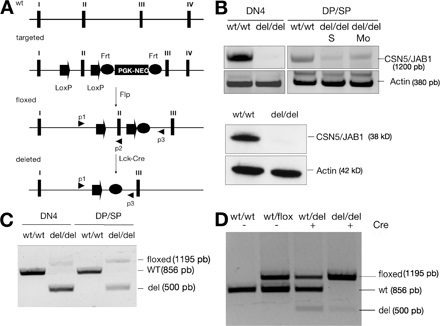
[View Larger Version of this Image]
Figure S1. Tissue-specific targeted disruption of the CSN5/JAB1 locus. (A) Strategy for targeting of exon II of the mouse CSN5/JAB1 locus with LoxP sites (arrows). In the WT allele, exons are indicated as numbered boxes. The targeting vector was designed to generate, after homologous recombination, the targeted CSN5/JAB1 allele with floxed exon 2 (LoxP; arrows) and the PGK-neo cassette flanked by Frt sites (ovals). To generate the floxed allele, the neo cassette was removed by crossing with FLPe deleter mice. Cre-mediated deletion of the floxed allele leads to out-of-frame rejoining and results in the deleted allele. Arrowheads, labeled p1 and p2, indicate the position and the orientation of the primers used to detect the floxed allele; the arrowhead–labeled p3 indicates the position and the orientation of the primer used to detect the deleted allele. (B; top) semiquantitative RT-PCR for CSN5/JAB1 in the indicated subsets of WT or CSN5/JAB1del/del thymocytes. (bottom) Immunoblot analysis of total thymocyte lysates from WT (lane 1) and CSN5/JAB1del/del (lane 2) mice using anti-CSN5/JAB1 antibody. β-actin is used as loading control. (C and D) PCR analysis of genomic DNA from thymocyte subsets (C) and peripheral blood (D) to detect the WT, floxed, and deleted CSN5/JAB1 allele. Genomic DNA was amplified using primers p1 and p3.